University Nursing: Clinical Simulation Reflection and Analysis Essay
VerifiedAdded on 2022/11/17
|9
|2034
|184
Essay
AI Summary
This reflection essay details a nursing student's experience in a clinical simulation involving a patient with respiratory issues. The student, acting as the exposure nurse, administered IV antibiotics and managed the patient's care. The essay reflects on the student's performance, highlighting both strengths, such as successful medication administration, and weaknesses, including lapses in hand hygiene and the failure to wear protective eyewear. The student analyzes the experience, referencing evidence-based practices and relevant literature to identify areas for improvement. The reflection concludes with an action plan outlining specific goals to enhance clinical skills, improve assertiveness, and incorporate evidence-based practices more consistently in future nursing practice. The essay emphasizes the importance of reflective practice in developing competence and professionalism in nursing, with the student aiming to improve knowledge and skills in exposure management and patient-centered care.
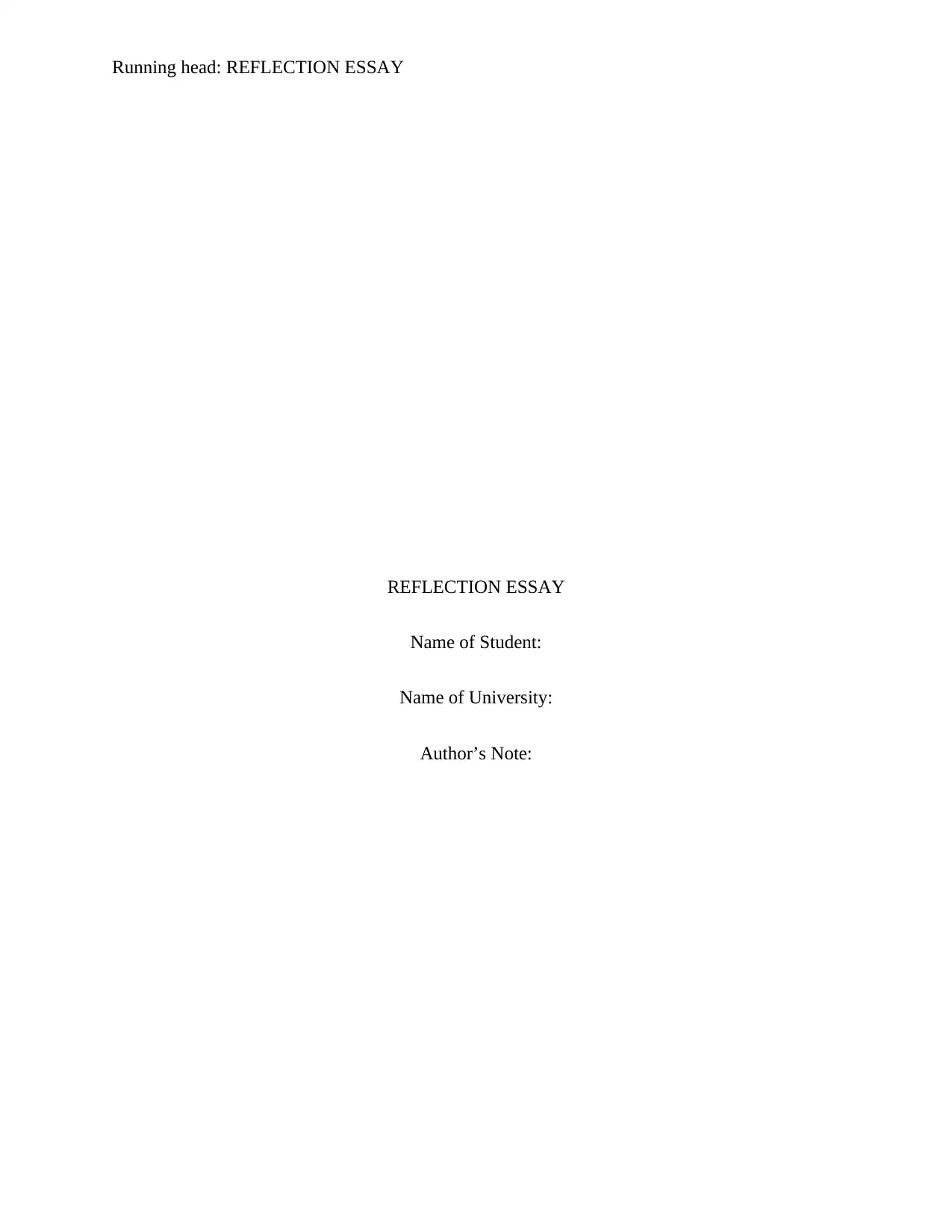
Running head: REFLECTION ESSAY
REFLECTION ESSAY
Name of Student:
Name of University:
Author’s Note:
REFLECTION ESSAY
Name of Student:
Name of University:
Author’s Note:
Paraphrase This Document
Need a fresh take? Get an instant paraphrase of this document with our AI Paraphraser
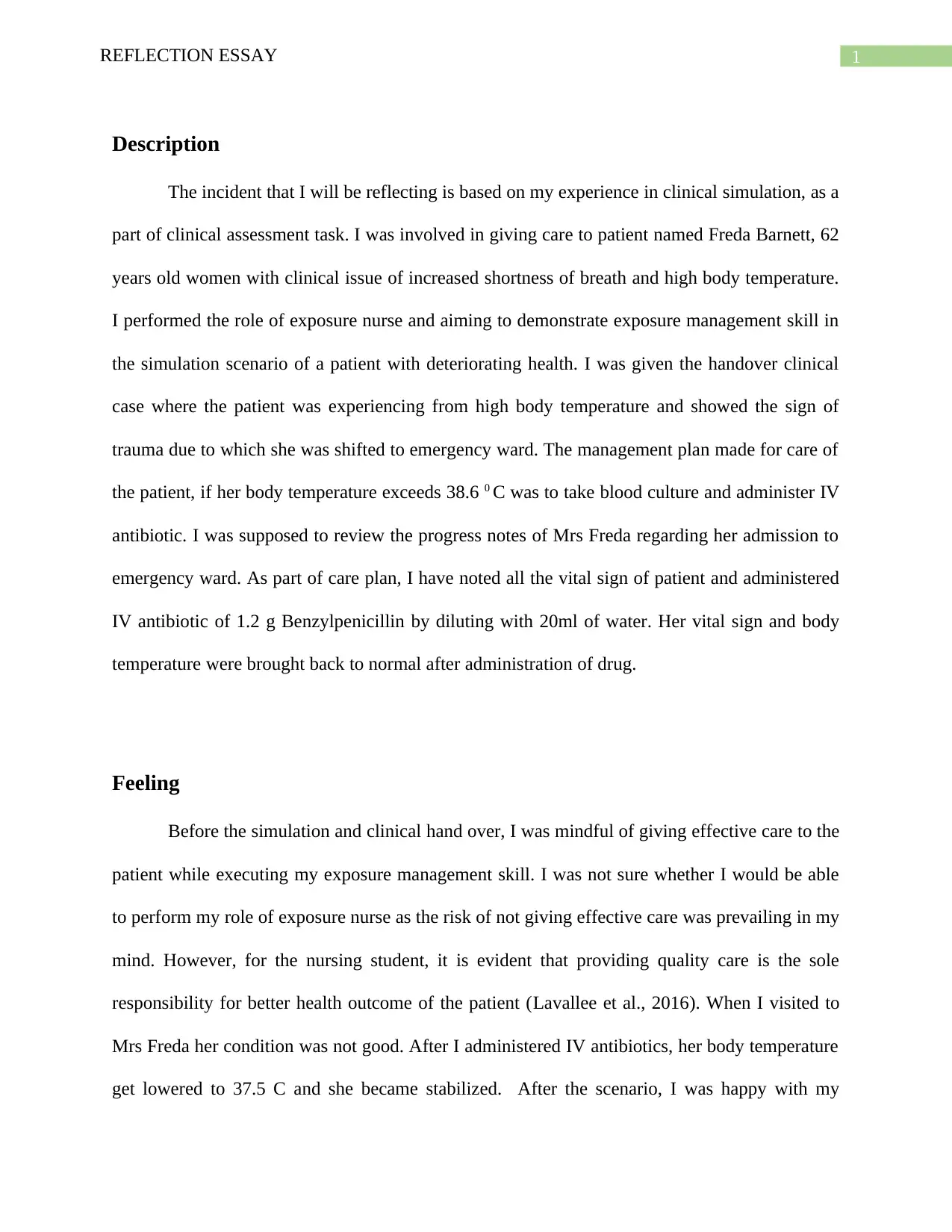
1REFLECTION ESSAY
Description
The incident that I will be reflecting is based on my experience in clinical simulation, as a
part of clinical assessment task. I was involved in giving care to patient named Freda Barnett, 62
years old women with clinical issue of increased shortness of breath and high body temperature.
I performed the role of exposure nurse and aiming to demonstrate exposure management skill in
the simulation scenario of a patient with deteriorating health. I was given the handover clinical
case where the patient was experiencing from high body temperature and showed the sign of
trauma due to which she was shifted to emergency ward. The management plan made for care of
the patient, if her body temperature exceeds 38.6 0 C was to take blood culture and administer IV
antibiotic. I was supposed to review the progress notes of Mrs Freda regarding her admission to
emergency ward. As part of care plan, I have noted all the vital sign of patient and administered
IV antibiotic of 1.2 g Benzylpenicillin by diluting with 20ml of water. Her vital sign and body
temperature were brought back to normal after administration of drug.
Feeling
Before the simulation and clinical hand over, I was mindful of giving effective care to the
patient while executing my exposure management skill. I was not sure whether I would be able
to perform my role of exposure nurse as the risk of not giving effective care was prevailing in my
mind. However, for the nursing student, it is evident that providing quality care is the sole
responsibility for better health outcome of the patient (Lavallee et al., 2016). When I visited to
Mrs Freda her condition was not good. After I administered IV antibiotics, her body temperature
get lowered to 37.5 C and she became stabilized. After the scenario, I was happy with my
Description
The incident that I will be reflecting is based on my experience in clinical simulation, as a
part of clinical assessment task. I was involved in giving care to patient named Freda Barnett, 62
years old women with clinical issue of increased shortness of breath and high body temperature.
I performed the role of exposure nurse and aiming to demonstrate exposure management skill in
the simulation scenario of a patient with deteriorating health. I was given the handover clinical
case where the patient was experiencing from high body temperature and showed the sign of
trauma due to which she was shifted to emergency ward. The management plan made for care of
the patient, if her body temperature exceeds 38.6 0 C was to take blood culture and administer IV
antibiotic. I was supposed to review the progress notes of Mrs Freda regarding her admission to
emergency ward. As part of care plan, I have noted all the vital sign of patient and administered
IV antibiotic of 1.2 g Benzylpenicillin by diluting with 20ml of water. Her vital sign and body
temperature were brought back to normal after administration of drug.
Feeling
Before the simulation and clinical hand over, I was mindful of giving effective care to the
patient while executing my exposure management skill. I was not sure whether I would be able
to perform my role of exposure nurse as the risk of not giving effective care was prevailing in my
mind. However, for the nursing student, it is evident that providing quality care is the sole
responsibility for better health outcome of the patient (Lavallee et al., 2016). When I visited to
Mrs Freda her condition was not good. After I administered IV antibiotics, her body temperature
get lowered to 37.5 C and she became stabilized. After the scenario, I was happy with my
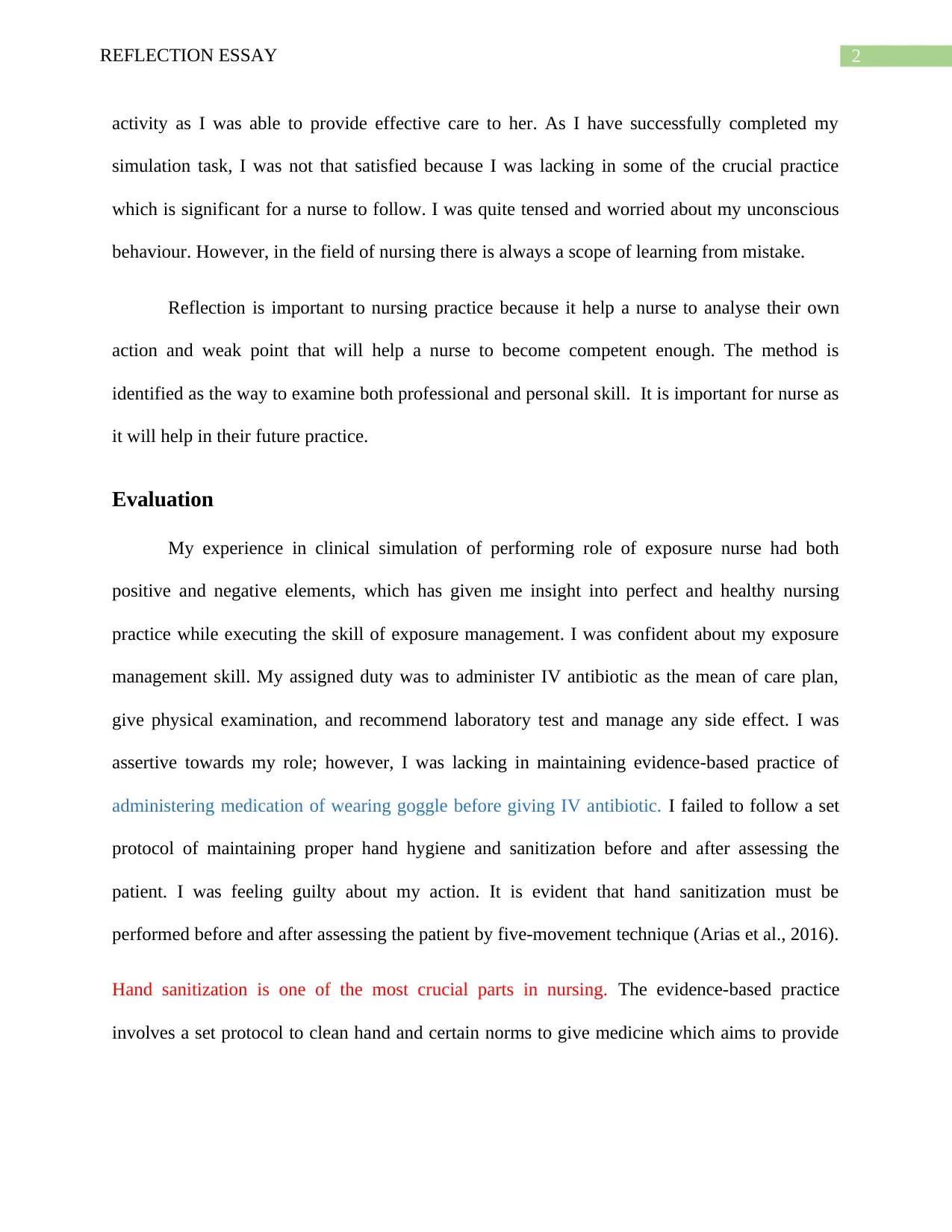
2REFLECTION ESSAY
activity as I was able to provide effective care to her. As I have successfully completed my
simulation task, I was not that satisfied because I was lacking in some of the crucial practice
which is significant for a nurse to follow. I was quite tensed and worried about my unconscious
behaviour. However, in the field of nursing there is always a scope of learning from mistake.
Reflection is important to nursing practice because it help a nurse to analyse their own
action and weak point that will help a nurse to become competent enough. The method is
identified as the way to examine both professional and personal skill. It is important for nurse as
it will help in their future practice.
Evaluation
My experience in clinical simulation of performing role of exposure nurse had both
positive and negative elements, which has given me insight into perfect and healthy nursing
practice while executing the skill of exposure management. I was confident about my exposure
management skill. My assigned duty was to administer IV antibiotic as the mean of care plan,
give physical examination, and recommend laboratory test and manage any side effect. I was
assertive towards my role; however, I was lacking in maintaining evidence-based practice of
administering medication of wearing goggle before giving IV antibiotic. I failed to follow a set
protocol of maintaining proper hand hygiene and sanitization before and after assessing the
patient. I was feeling guilty about my action. It is evident that hand sanitization must be
performed before and after assessing the patient by five-movement technique (Arias et al., 2016).
Hand sanitization is one of the most crucial parts in nursing. The evidence-based practice
involves a set protocol to clean hand and certain norms to give medicine which aims to provide
activity as I was able to provide effective care to her. As I have successfully completed my
simulation task, I was not that satisfied because I was lacking in some of the crucial practice
which is significant for a nurse to follow. I was quite tensed and worried about my unconscious
behaviour. However, in the field of nursing there is always a scope of learning from mistake.
Reflection is important to nursing practice because it help a nurse to analyse their own
action and weak point that will help a nurse to become competent enough. The method is
identified as the way to examine both professional and personal skill. It is important for nurse as
it will help in their future practice.
Evaluation
My experience in clinical simulation of performing role of exposure nurse had both
positive and negative elements, which has given me insight into perfect and healthy nursing
practice while executing the skill of exposure management. I was confident about my exposure
management skill. My assigned duty was to administer IV antibiotic as the mean of care plan,
give physical examination, and recommend laboratory test and manage any side effect. I was
assertive towards my role; however, I was lacking in maintaining evidence-based practice of
administering medication of wearing goggle before giving IV antibiotic. I failed to follow a set
protocol of maintaining proper hand hygiene and sanitization before and after assessing the
patient. I was feeling guilty about my action. It is evident that hand sanitization must be
performed before and after assessing the patient by five-movement technique (Arias et al., 2016).
Hand sanitization is one of the most crucial parts in nursing. The evidence-based practice
involves a set protocol to clean hand and certain norms to give medicine which aims to provide
⊘ This is a preview!⊘
Do you want full access?
Subscribe today to unlock all pages.

Trusted by 1+ million students worldwide
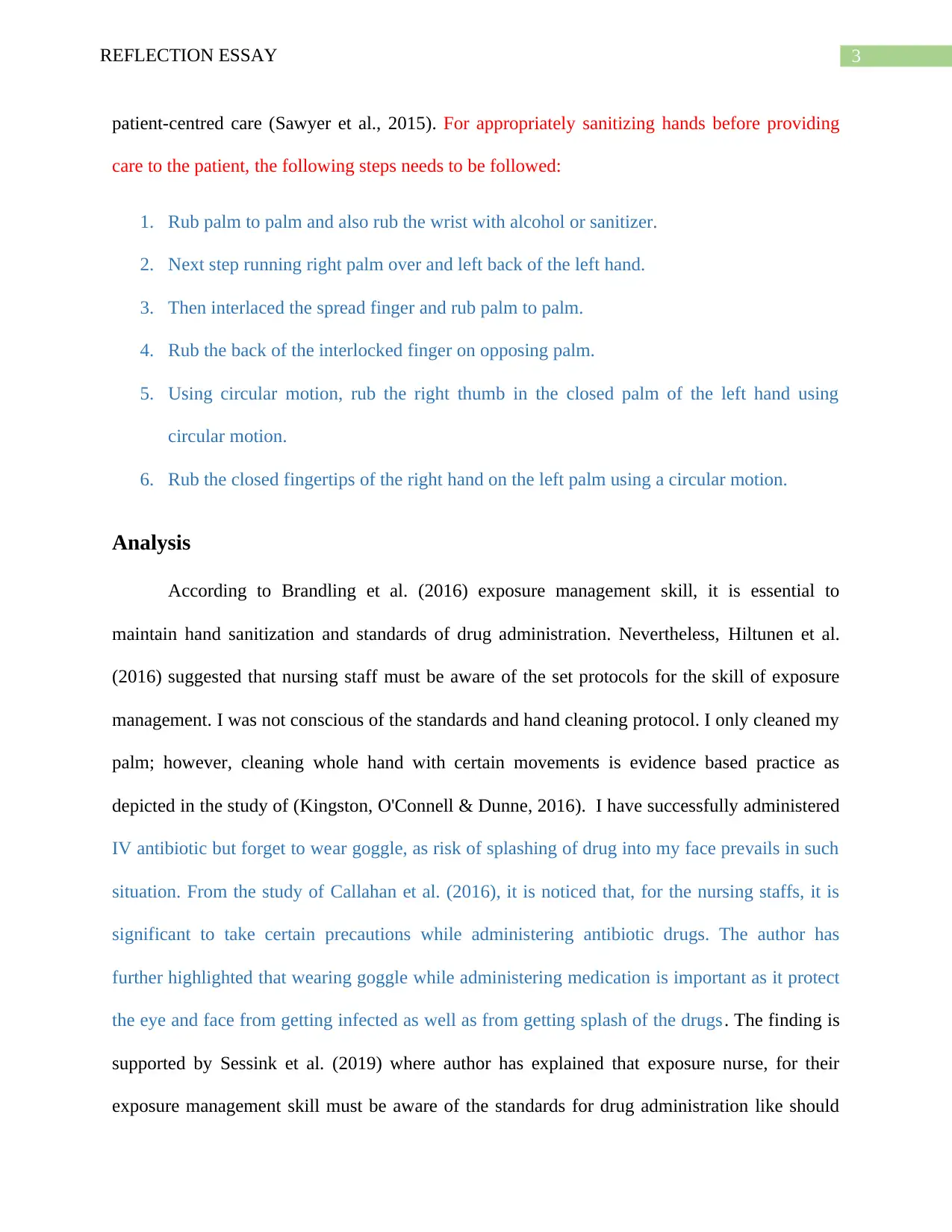
3REFLECTION ESSAY
patient-centred care (Sawyer et al., 2015). For appropriately sanitizing hands before providing
care to the patient, the following steps needs to be followed:
1. Rub palm to palm and also rub the wrist with alcohol or sanitizer.
2. Next step running right palm over and left back of the left hand.
3. Then interlaced the spread finger and rub palm to palm.
4. Rub the back of the interlocked finger on opposing palm.
5. Using circular motion, rub the right thumb in the closed palm of the left hand using
circular motion.
6. Rub the closed fingertips of the right hand on the left palm using a circular motion.
Analysis
According to Brandling et al. (2016) exposure management skill, it is essential to
maintain hand sanitization and standards of drug administration. Nevertheless, Hiltunen et al.
(2016) suggested that nursing staff must be aware of the set protocols for the skill of exposure
management. I was not conscious of the standards and hand cleaning protocol. I only cleaned my
palm; however, cleaning whole hand with certain movements is evidence based practice as
depicted in the study of (Kingston, O'Connell & Dunne, 2016). I have successfully administered
IV antibiotic but forget to wear goggle, as risk of splashing of drug into my face prevails in such
situation. From the study of Callahan et al. (2016), it is noticed that, for the nursing staffs, it is
significant to take certain precautions while administering antibiotic drugs. The author has
further highlighted that wearing goggle while administering medication is important as it protect
the eye and face from getting infected as well as from getting splash of the drugs. The finding is
supported by Sessink et al. (2019) where author has explained that exposure nurse, for their
exposure management skill must be aware of the standards for drug administration like should
patient-centred care (Sawyer et al., 2015). For appropriately sanitizing hands before providing
care to the patient, the following steps needs to be followed:
1. Rub palm to palm and also rub the wrist with alcohol or sanitizer.
2. Next step running right palm over and left back of the left hand.
3. Then interlaced the spread finger and rub palm to palm.
4. Rub the back of the interlocked finger on opposing palm.
5. Using circular motion, rub the right thumb in the closed palm of the left hand using
circular motion.
6. Rub the closed fingertips of the right hand on the left palm using a circular motion.
Analysis
According to Brandling et al. (2016) exposure management skill, it is essential to
maintain hand sanitization and standards of drug administration. Nevertheless, Hiltunen et al.
(2016) suggested that nursing staff must be aware of the set protocols for the skill of exposure
management. I was not conscious of the standards and hand cleaning protocol. I only cleaned my
palm; however, cleaning whole hand with certain movements is evidence based practice as
depicted in the study of (Kingston, O'Connell & Dunne, 2016). I have successfully administered
IV antibiotic but forget to wear goggle, as risk of splashing of drug into my face prevails in such
situation. From the study of Callahan et al. (2016), it is noticed that, for the nursing staffs, it is
significant to take certain precautions while administering antibiotic drugs. The author has
further highlighted that wearing goggle while administering medication is important as it protect
the eye and face from getting infected as well as from getting splash of the drugs. The finding is
supported by Sessink et al. (2019) where author has explained that exposure nurse, for their
exposure management skill must be aware of the standards for drug administration like should
Paraphrase This Document
Need a fresh take? Get an instant paraphrase of this document with our AI Paraphraser
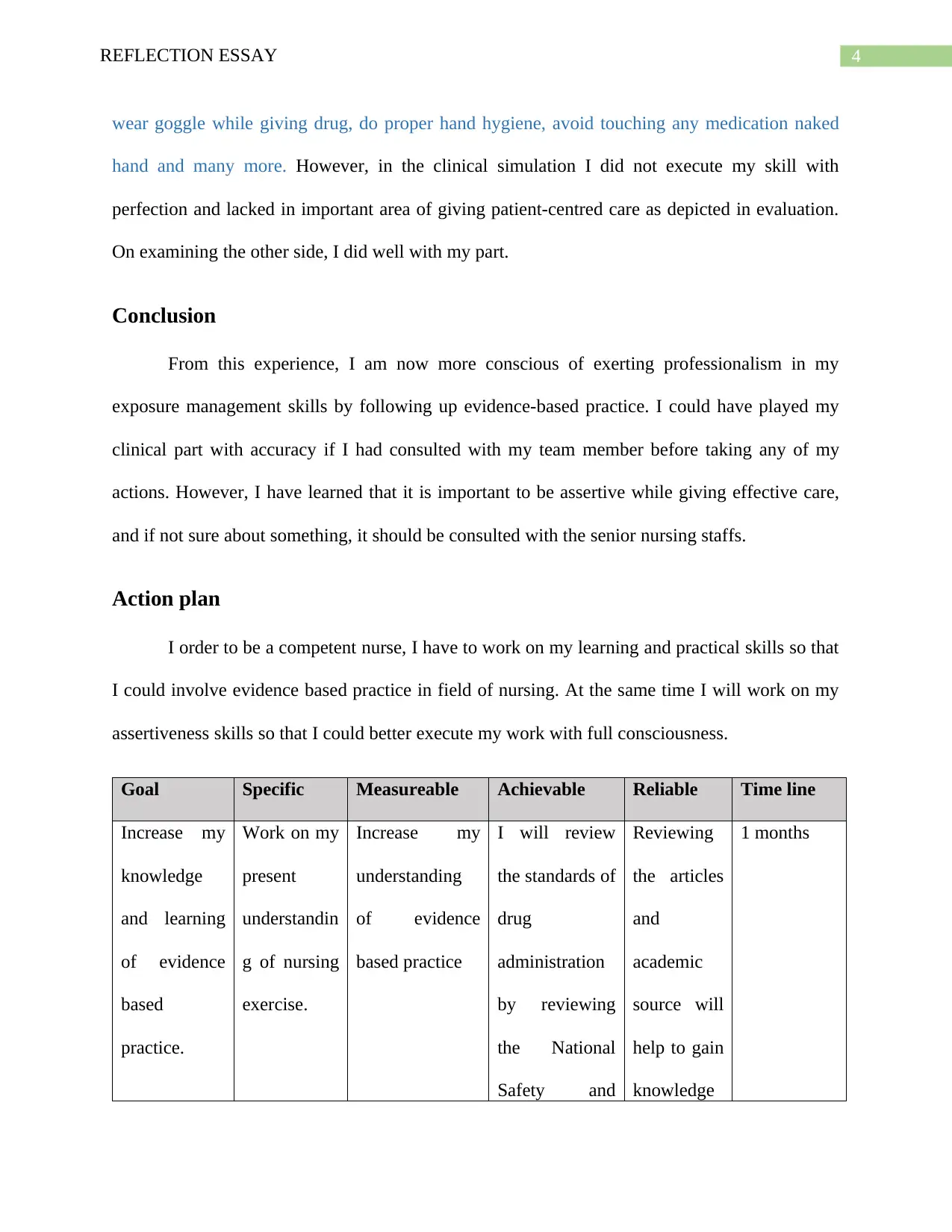
4REFLECTION ESSAY
wear goggle while giving drug, do proper hand hygiene, avoid touching any medication naked
hand and many more. However, in the clinical simulation I did not execute my skill with
perfection and lacked in important area of giving patient-centred care as depicted in evaluation.
On examining the other side, I did well with my part.
Conclusion
From this experience, I am now more conscious of exerting professionalism in my
exposure management skills by following up evidence-based practice. I could have played my
clinical part with accuracy if I had consulted with my team member before taking any of my
actions. However, I have learned that it is important to be assertive while giving effective care,
and if not sure about something, it should be consulted with the senior nursing staffs.
Action plan
I order to be a competent nurse, I have to work on my learning and practical skills so that
I could involve evidence based practice in field of nursing. At the same time I will work on my
assertiveness skills so that I could better execute my work with full consciousness.
Goal Specific Measureable Achievable Reliable Time line
Increase my
knowledge
and learning
of evidence
based
practice.
Work on my
present
understandin
g of nursing
exercise.
Increase my
understanding
of evidence
based practice
I will review
the standards of
drug
administration
by reviewing
the National
Safety and
Reviewing
the articles
and
academic
source will
help to gain
knowledge
1 months
wear goggle while giving drug, do proper hand hygiene, avoid touching any medication naked
hand and many more. However, in the clinical simulation I did not execute my skill with
perfection and lacked in important area of giving patient-centred care as depicted in evaluation.
On examining the other side, I did well with my part.
Conclusion
From this experience, I am now more conscious of exerting professionalism in my
exposure management skills by following up evidence-based practice. I could have played my
clinical part with accuracy if I had consulted with my team member before taking any of my
actions. However, I have learned that it is important to be assertive while giving effective care,
and if not sure about something, it should be consulted with the senior nursing staffs.
Action plan
I order to be a competent nurse, I have to work on my learning and practical skills so that
I could involve evidence based practice in field of nursing. At the same time I will work on my
assertiveness skills so that I could better execute my work with full consciousness.
Goal Specific Measureable Achievable Reliable Time line
Increase my
knowledge
and learning
of evidence
based
practice.
Work on my
present
understandin
g of nursing
exercise.
Increase my
understanding
of evidence
based practice
I will review
the standards of
drug
administration
by reviewing
the National
Safety and
Reviewing
the articles
and
academic
source will
help to gain
knowledge
1 months
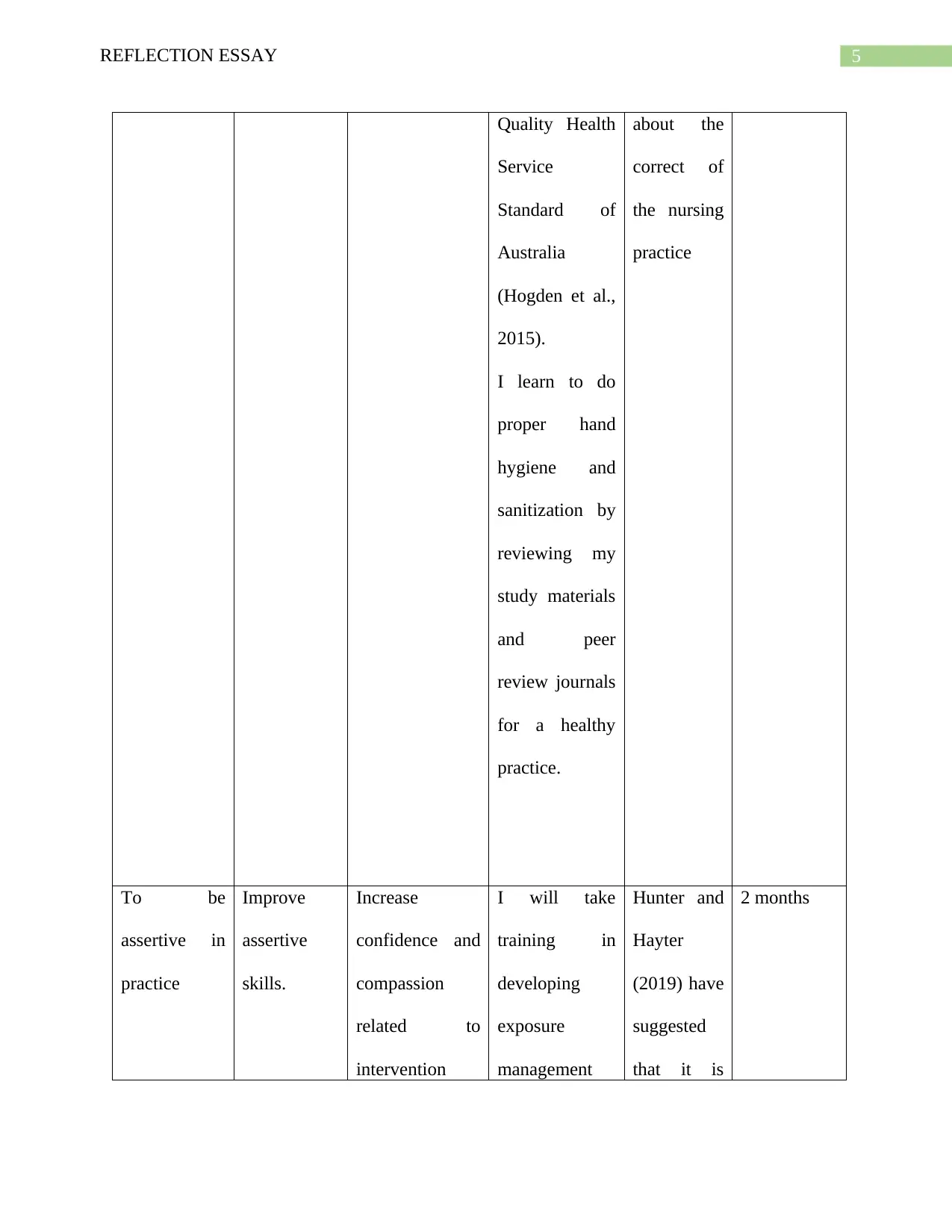
5REFLECTION ESSAY
Quality Health
Service
Standard of
Australia
(Hogden et al.,
2015).
I learn to do
proper hand
hygiene and
sanitization by
reviewing my
study materials
and peer
review journals
for a healthy
practice.
about the
correct of
the nursing
practice
To be
assertive in
practice
Improve
assertive
skills.
Increase
confidence and
compassion
related to
intervention
I will take
training in
developing
exposure
management
Hunter and
Hayter
(2019) have
suggested
that it is
2 months
Quality Health
Service
Standard of
Australia
(Hogden et al.,
2015).
I learn to do
proper hand
hygiene and
sanitization by
reviewing my
study materials
and peer
review journals
for a healthy
practice.
about the
correct of
the nursing
practice
To be
assertive in
practice
Improve
assertive
skills.
Increase
confidence and
compassion
related to
intervention
I will take
training in
developing
exposure
management
Hunter and
Hayter
(2019) have
suggested
that it is
2 months
⊘ This is a preview!⊘
Do you want full access?
Subscribe today to unlock all pages.

Trusted by 1+ million students worldwide
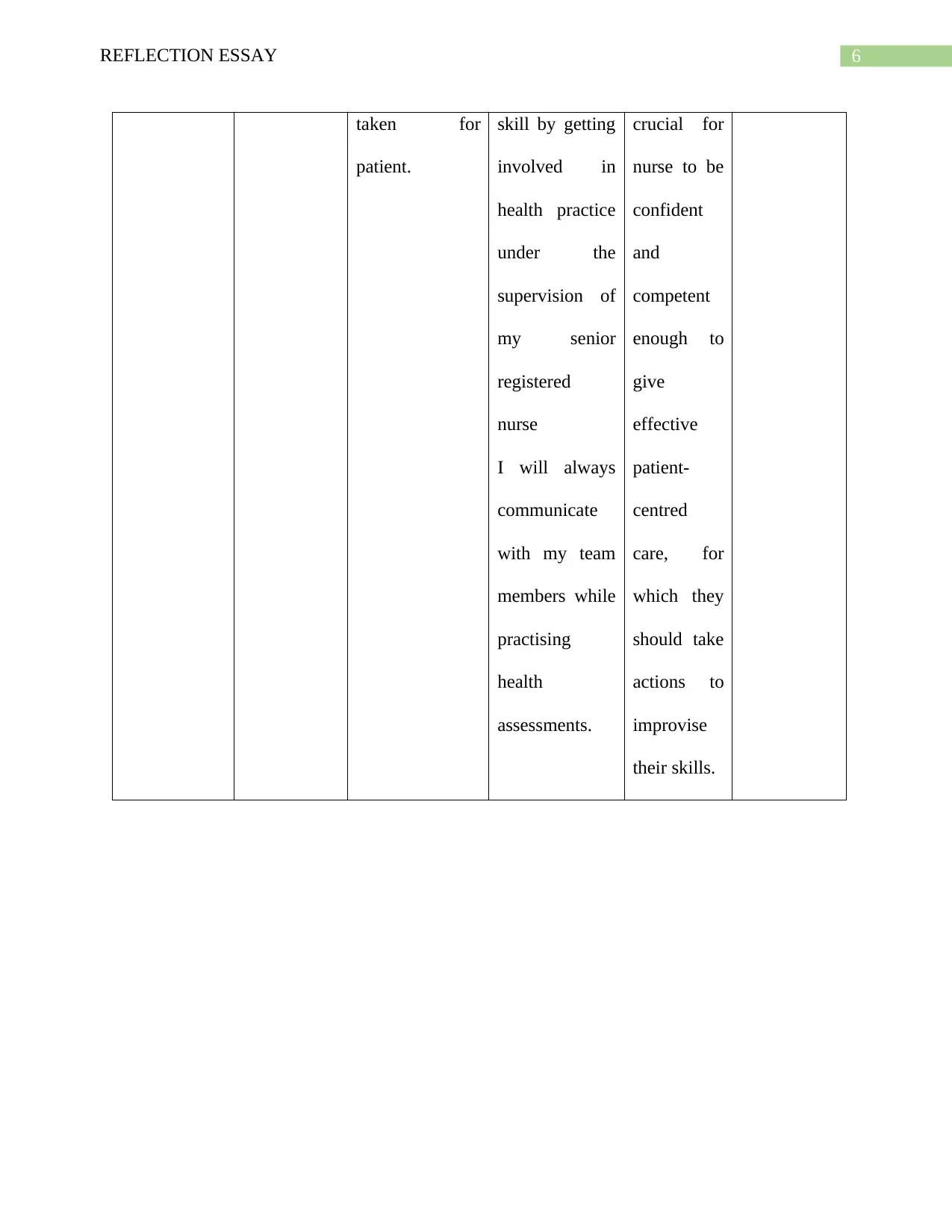
6REFLECTION ESSAY
taken for
patient.
skill by getting
involved in
health practice
under the
supervision of
my senior
registered
nurse
I will always
communicate
with my team
members while
practising
health
assessments.
crucial for
nurse to be
confident
and
competent
enough to
give
effective
patient-
centred
care, for
which they
should take
actions to
improvise
their skills.
taken for
patient.
skill by getting
involved in
health practice
under the
supervision of
my senior
registered
nurse
I will always
communicate
with my team
members while
practising
health
assessments.
crucial for
nurse to be
confident
and
competent
enough to
give
effective
patient-
centred
care, for
which they
should take
actions to
improvise
their skills.
Paraphrase This Document
Need a fresh take? Get an instant paraphrase of this document with our AI Paraphraser
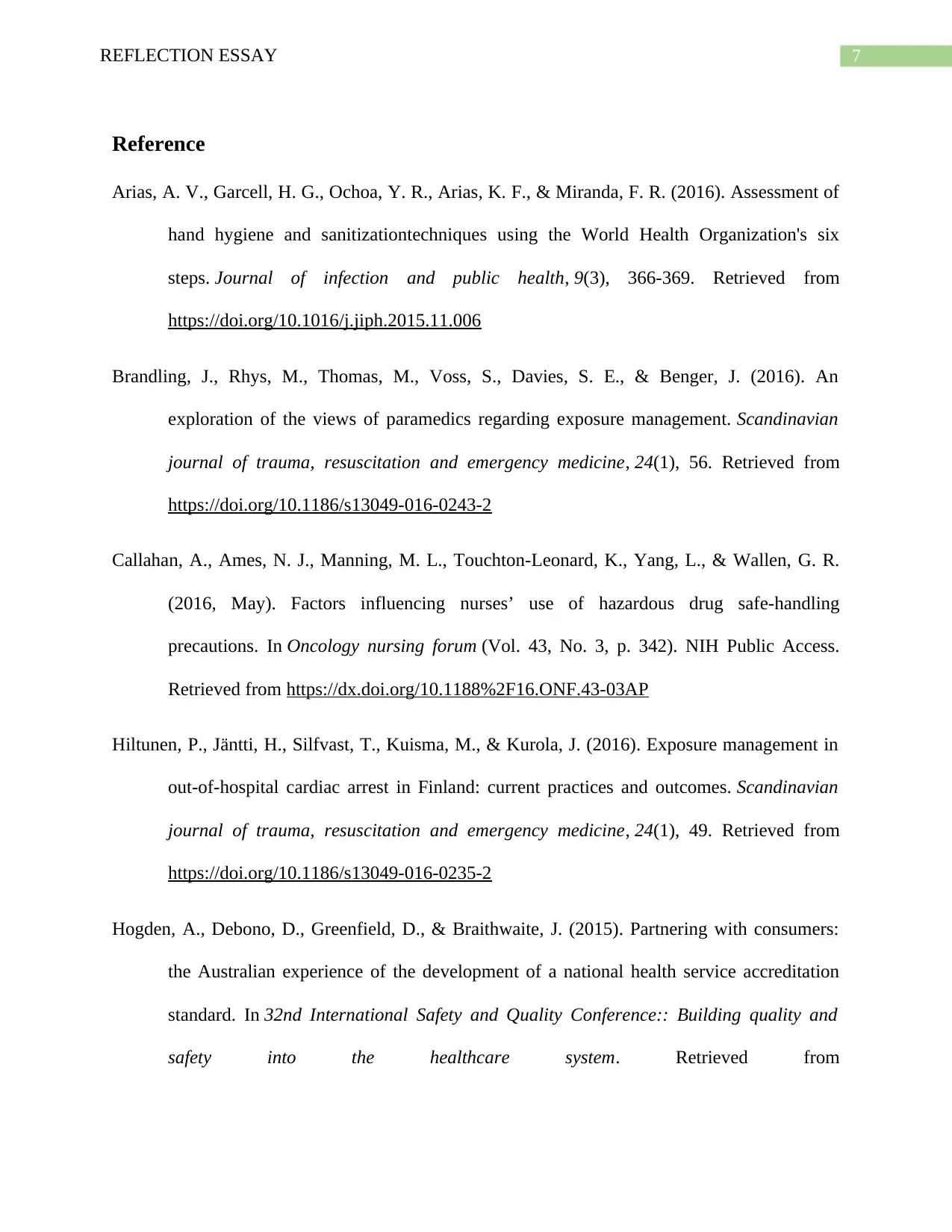
7REFLECTION ESSAY
Reference
Arias, A. V., Garcell, H. G., Ochoa, Y. R., Arias, K. F., & Miranda, F. R. (2016). Assessment of
hand hygiene and sanitizationtechniques using the World Health Organization's six
steps. Journal of infection and public health, 9(3), 366-369. Retrieved from
https://doi.org/10.1016/j.jiph.2015.11.006
Brandling, J., Rhys, M., Thomas, M., Voss, S., Davies, S. E., & Benger, J. (2016). An
exploration of the views of paramedics regarding exposure management. Scandinavian
journal of trauma, resuscitation and emergency medicine, 24(1), 56. Retrieved from
https://doi.org/10.1186/s13049-016-0243-2
Callahan, A., Ames, N. J., Manning, M. L., Touchton-Leonard, K., Yang, L., & Wallen, G. R.
(2016, May). Factors influencing nurses’ use of hazardous drug safe-handling
precautions. In Oncology nursing forum (Vol. 43, No. 3, p. 342). NIH Public Access.
Retrieved from https://dx.doi.org/10.1188%2F16.ONF.43-03AP
Hiltunen, P., Jäntti, H., Silfvast, T., Kuisma, M., & Kurola, J. (2016). Exposure management in
out-of-hospital cardiac arrest in Finland: current practices and outcomes. Scandinavian
journal of trauma, resuscitation and emergency medicine, 24(1), 49. Retrieved from
https://doi.org/10.1186/s13049-016-0235-2
Hogden, A., Debono, D., Greenfield, D., & Braithwaite, J. (2015). Partnering with consumers:
the Australian experience of the development of a national health service accreditation
standard. In 32nd International Safety and Quality Conference:: Building quality and
safety into the healthcare system. Retrieved from
Reference
Arias, A. V., Garcell, H. G., Ochoa, Y. R., Arias, K. F., & Miranda, F. R. (2016). Assessment of
hand hygiene and sanitizationtechniques using the World Health Organization's six
steps. Journal of infection and public health, 9(3), 366-369. Retrieved from
https://doi.org/10.1016/j.jiph.2015.11.006
Brandling, J., Rhys, M., Thomas, M., Voss, S., Davies, S. E., & Benger, J. (2016). An
exploration of the views of paramedics regarding exposure management. Scandinavian
journal of trauma, resuscitation and emergency medicine, 24(1), 56. Retrieved from
https://doi.org/10.1186/s13049-016-0243-2
Callahan, A., Ames, N. J., Manning, M. L., Touchton-Leonard, K., Yang, L., & Wallen, G. R.
(2016, May). Factors influencing nurses’ use of hazardous drug safe-handling
precautions. In Oncology nursing forum (Vol. 43, No. 3, p. 342). NIH Public Access.
Retrieved from https://dx.doi.org/10.1188%2F16.ONF.43-03AP
Hiltunen, P., Jäntti, H., Silfvast, T., Kuisma, M., & Kurola, J. (2016). Exposure management in
out-of-hospital cardiac arrest in Finland: current practices and outcomes. Scandinavian
journal of trauma, resuscitation and emergency medicine, 24(1), 49. Retrieved from
https://doi.org/10.1186/s13049-016-0235-2
Hogden, A., Debono, D., Greenfield, D., & Braithwaite, J. (2015). Partnering with consumers:
the Australian experience of the development of a national health service accreditation
standard. In 32nd International Safety and Quality Conference:: Building quality and
safety into the healthcare system. Retrieved from
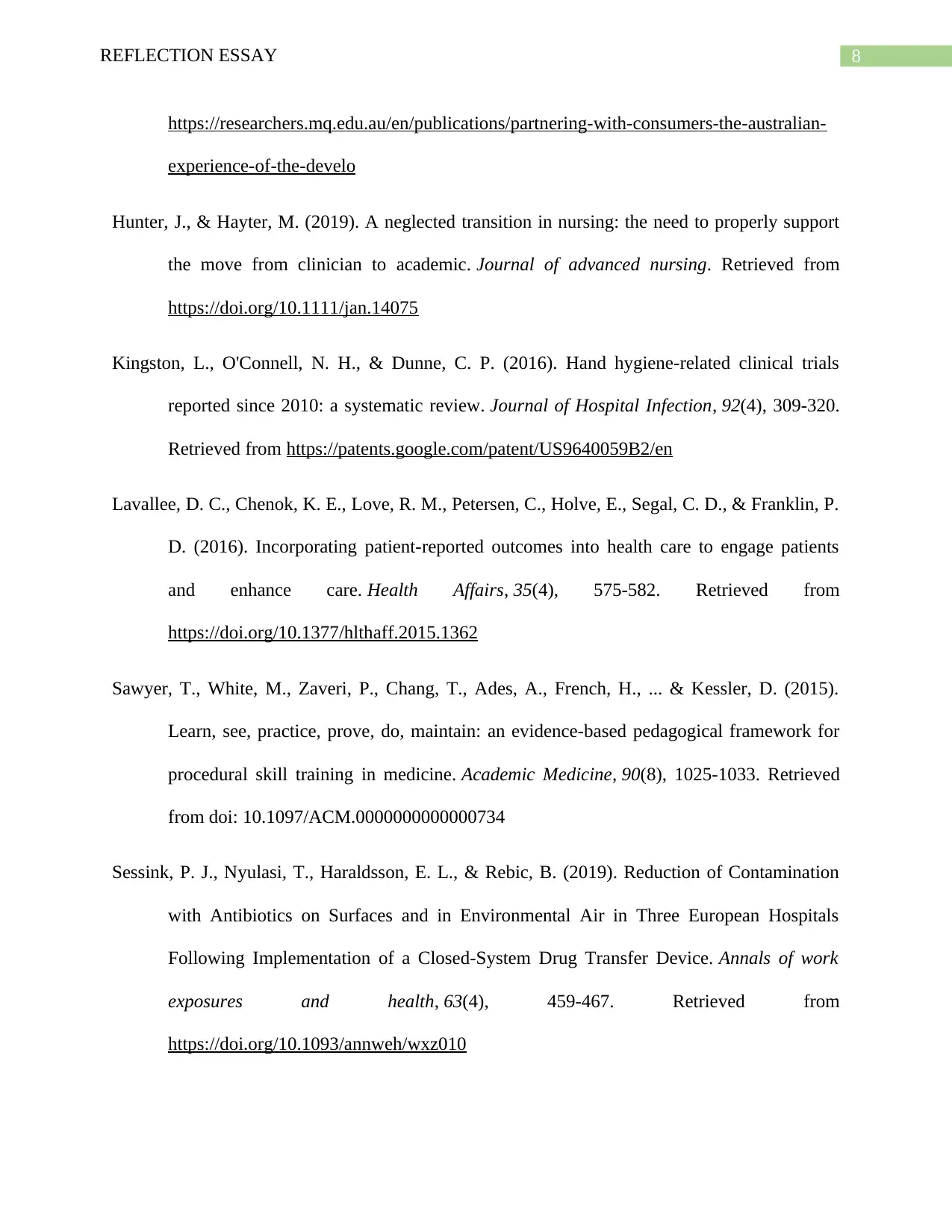
8REFLECTION ESSAY
https://researchers.mq.edu.au/en/publications/partnering-with-consumers-the-australian-
experience-of-the-develo
Hunter, J., & Hayter, M. (2019). A neglected transition in nursing: the need to properly support
the move from clinician to academic. Journal of advanced nursing. Retrieved from
https://doi.org/10.1111/jan.14075
Kingston, L., O'Connell, N. H., & Dunne, C. P. (2016). Hand hygiene-related clinical trials
reported since 2010: a systematic review. Journal of Hospital Infection, 92(4), 309-320.
Retrieved from https://patents.google.com/patent/US9640059B2/en
Lavallee, D. C., Chenok, K. E., Love, R. M., Petersen, C., Holve, E., Segal, C. D., & Franklin, P.
D. (2016). Incorporating patient-reported outcomes into health care to engage patients
and enhance care. Health Affairs, 35(4), 575-582. Retrieved from
https://doi.org/10.1377/hlthaff.2015.1362
Sawyer, T., White, M., Zaveri, P., Chang, T., Ades, A., French, H., ... & Kessler, D. (2015).
Learn, see, practice, prove, do, maintain: an evidence-based pedagogical framework for
procedural skill training in medicine. Academic Medicine, 90(8), 1025-1033. Retrieved
from doi: 10.1097/ACM.0000000000000734
Sessink, P. J., Nyulasi, T., Haraldsson, E. L., & Rebic, B. (2019). Reduction of Contamination
with Antibiotics on Surfaces and in Environmental Air in Three European Hospitals
Following Implementation of a Closed-System Drug Transfer Device. Annals of work
exposures and health, 63(4), 459-467. Retrieved from
https://doi.org/10.1093/annweh/wxz010
https://researchers.mq.edu.au/en/publications/partnering-with-consumers-the-australian-
experience-of-the-develo
Hunter, J., & Hayter, M. (2019). A neglected transition in nursing: the need to properly support
the move from clinician to academic. Journal of advanced nursing. Retrieved from
https://doi.org/10.1111/jan.14075
Kingston, L., O'Connell, N. H., & Dunne, C. P. (2016). Hand hygiene-related clinical trials
reported since 2010: a systematic review. Journal of Hospital Infection, 92(4), 309-320.
Retrieved from https://patents.google.com/patent/US9640059B2/en
Lavallee, D. C., Chenok, K. E., Love, R. M., Petersen, C., Holve, E., Segal, C. D., & Franklin, P.
D. (2016). Incorporating patient-reported outcomes into health care to engage patients
and enhance care. Health Affairs, 35(4), 575-582. Retrieved from
https://doi.org/10.1377/hlthaff.2015.1362
Sawyer, T., White, M., Zaveri, P., Chang, T., Ades, A., French, H., ... & Kessler, D. (2015).
Learn, see, practice, prove, do, maintain: an evidence-based pedagogical framework for
procedural skill training in medicine. Academic Medicine, 90(8), 1025-1033. Retrieved
from doi: 10.1097/ACM.0000000000000734
Sessink, P. J., Nyulasi, T., Haraldsson, E. L., & Rebic, B. (2019). Reduction of Contamination
with Antibiotics on Surfaces and in Environmental Air in Three European Hospitals
Following Implementation of a Closed-System Drug Transfer Device. Annals of work
exposures and health, 63(4), 459-467. Retrieved from
https://doi.org/10.1093/annweh/wxz010
⊘ This is a preview!⊘
Do you want full access?
Subscribe today to unlock all pages.

Trusted by 1+ million students worldwide
1 out of 9
Related Documents
Your All-in-One AI-Powered Toolkit for Academic Success.
+13062052269
info@desklib.com
Available 24*7 on WhatsApp / Email
![[object Object]](/_next/static/media/star-bottom.7253800d.svg)
Unlock your academic potential
Copyright © 2020–2025 A2Z Services. All Rights Reserved. Developed and managed by ZUCOL.





